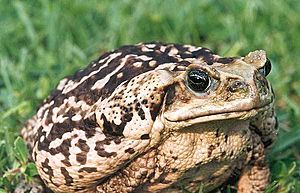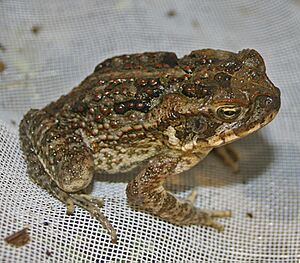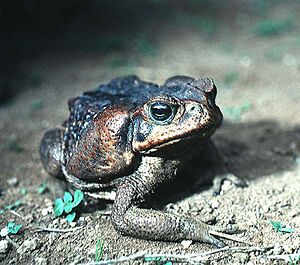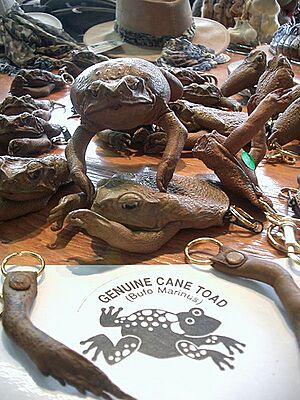Cane toad facts for kids
Quick facts for kids Cane toad |
|
|---|---|
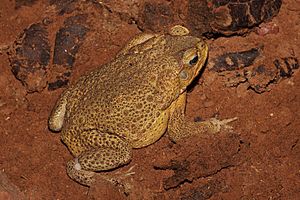 |
|
| Adult male cane toad | |
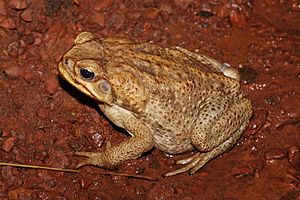 |
|
| Adult female cane toad | |
| Conservation status | |
| Scientific classification | |
| Genus: |
Rhinella
|
| Species: |
marina
|
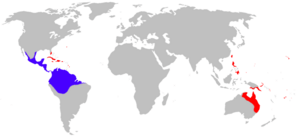 |
|
| Where cane toads live: native areas (blue), introduced areas (red) | |
| Synonyms | |
|
|
The cane toad (Rhinella marina) is a very large toad. It is also called the giant neotropical toad or marine toad. These toads are originally from South America and Central America. However, people have moved them to many islands in Oceania and the Caribbean, and also to Northern Australia. The cane toad belongs to a group of toads called Rhinella.
Cane toads are very good at having babies. A female can lay thousands of eggs at once. They eat many different things, both dead and alive, which is unusual for frogs. Adult cane toads are usually about 10 to 15 centimeters (4 to 6 inches) long. The biggest one ever found was 24 centimeters (9.4 inches) long!
Cane toads have special glands that produce poison. Their babies (tadpoles) are also very poisonous if eaten. This poison can harm or even kill many animals, including pets like dogs. People first brought cane toads to many places to help control farm pests. For example, they were used to fight the cane beetle that damaged sugar cane plants. This is how they got their common name, "cane toad." But now, in many places where they were introduced, cane toads have become a pest themselves. They are known as an invasive species. The 1988 movie Cane Toads: An Unnatural History showed the problems caused by cane toads in Australia.
Contents
What Does a Cane Toad Look Like?
Cane toads are known for being very big. Female toads are usually bigger than males. They typically grow to be 10 to 15 centimeters (4 to 6 inches) long. The largest recorded cane toad was 24 centimeters (9.4 inches) long. Toads that live in areas with fewer other toads tend to grow bigger. In the wild, they usually live for 10 to 15 years. In zoos or as pets, they can live much longer. One toad reportedly lived for 35 years!
Cane toads have dry, bumpy skin. They have special ridges above their eyes that go down to their nose. Their skin can be grey, yellowish, reddish-brown, or olive-brown, with different patterns. Behind each eye, they have a large gland called a parotoid gland. Their belly is usually cream-colored and might have dark spots. Their eyes have horizontal pupils and golden irises. Their toes have a bit of webbing at the bottom, but their fingers do not.
Young cane toads usually have smooth, dark skin. Some might have a reddish color. They don't have the big parotoid glands that adult toads have, so they are less poisonous. Cane toad tadpoles are small and completely black. They live at the bottom of the water and often swim in large groups. Tadpoles are about 10 to 25 millimeters (0.4 to 1 inch) long.
How Do Cane Toads Live and Behave?
The name "marine toad" might make you think they live in the sea. But cane toads do not live in saltwater. However, their tadpoles can handle some salt in the water. They have been found in water that is quite salty, like 27.5 parts per thousand. This is about three-quarters as salty as seawater. Cane toads live in open grasslands and woodlands. They really like areas changed by humans, such as gardens and ditches. In their natural homes, they can be found in warm, wet forests.
Life Cycle of a Cane Toad
A cane toad's life starts as an egg. These eggs are laid in long, jelly-like strings in the water. A female toad can lay between 8,000 and 25,000 eggs at one time. These strings can be up to 20 meters (66 feet) long! The eggs are black and about 1.7 to 2.0 millimeters (0.07 to 0.08 inches) wide.
The warmer the water, the faster the eggs hatch. Tadpoles usually hatch within 48 hours, but it can take from 14 hours to almost a week. Thousands of tiny, black tadpoles with short tails often swim together in groups. It takes about 12 to 60 days for tadpoles to become young toads, with four weeks being common. Just like adult toads, the eggs and tadpoles are poisonous to many animals.
When they first become toadlets, they are about 10 to 11 millimeters (0.4 inches) long. They grow very quickly. Their growth rate can change depending on the area, time of year, and whether they are male or female. Growth usually slows down once the toads are old enough to have their own babies.
Toads become old enough to reproduce at different sizes in different places. In New Guinea, females can reproduce when they are 70 to 80 millimeters (2.8 to 3.1 inches) long. In Panama, they need to be 90 to 100 millimeters (3.5 to 3.9 inches) long. In warm, tropical areas, they can reproduce all year. But in places with seasons, they only reproduce during warmer, wet times.
Cane toads can handle a wide range of temperatures. They can survive in temperatures from about 10–15°C (50–59°F) up to 40–42°C (104–108°F). They can even adjust to cold temperatures quickly. This ability helps them spread to many new places around the world. They can also survive losing a lot of body water, which helps them live outside very wet areas.
What Do Cane Toads Eat?
Most frogs find their food by seeing movement. Cane toads mainly use their eyesight to find prey, but they can also smell food. They eat a huge variety of things. They eat small rodents, other small mammals, reptiles, other amphibians, birds, and even bats. They also eat many kinds of invertebrates like ants, beetles, earwigs, dragonflies, grasshoppers, and crustaceans. Besides animals, they will also eat plants, pet food, animal waste, and even trash from homes!
How Do Cane Toads Protect Themselves?
The skin of an adult cane toad is poisonous. The large glands behind their eyes, called parotoid glands, and other glands on their back also produce poison. When a cane toad feels threatened, these glands release a milky-white liquid called bufotoxin. This poison is harmful to many animals. There have even been rare cases of humans getting very sick from eating cane toads. Dogs are especially likely to get poisoned if they lick or bite a toad. If a pet shows signs like lots of drooling, very red gums, head shaking, crying, losing balance, or seizures, it needs to see a vet right away.
One of the chemicals in the toad's poison, called bufotenin, is illegal in some places. It can cause effects similar to mild poisoning, including mild hallucinations that last less than an hour. However, cane toads produce only small amounts of bufotenin and large amounts of other, more dangerous toxins. So, trying to "lick" a toad for its effects could lead to serious illness or even death.
Besides releasing poison, cane toads can also puff themselves up with air. They lift their bodies off the ground to look taller and bigger to animals that might want to eat them.
Scientists have tried different ways to protect native animals from cane toads. In Western Australia, they used poisonous sausages with toad meat. These baits were designed to teach native animals not to eat the toads. By mixing small pieces of toad with a chemical that makes animals feel sick, the baits train them to stay away from real toads.
Young cane toads that are not deadly have also been used as "teacher toads." These young toads were released in areas before the main invasion of wild toads. For example, yellow-spotted monitor lizards learned to avoid the toads this way. In areas without "teacher toads," many monitors died after wild cane toads arrived. But in areas with "teacher toads," many more monitors survived.
Who Eats Cane Toads?
In their native homes, many animals eat cane toads and their tadpoles. These include the broad-snouted caiman, the banded cat-eyed snake, eels, certain types of fish called killifish, and bullet ants.
In places where cane toads have been introduced, some animals have learned to eat them. These include the rock flagtail fish, some types of catfish, certain ibis birds, the whistling kite, the rakali (Australian water rat), the black rat, and the Asian water monitor. Some birds like the tawny frogmouth and Papuan frogmouth eat them. Australian crows have learned to flip toads onto their backs to eat them safely. Kookaburras also eat them.
Some animals, like opossums, seem to be able to eat cane toads without getting sick. Meat ants are not affected by the toad's toxins. Cane toads usually stand still when attacked, letting their poison work. This allows the ants to attack and eat the toad. Saw-shelled turtles have also been seen safely eating cane toads.
In Australia, rakali (Australian water rats) learned how to eat cane toads safely in just two years. They pick the biggest toads, flip them over, remove the poisonous gallbladder, and then eat the heart and other organs very carefully. They also remove the toxic skin and eat the thigh muscle. Other animals, like crows and kites, turn cane toads inside out to eat the non-poisonous parts, avoiding the skin.
Where Do Cane Toads Live?
Cane toads are naturally found in the Americas. Their native range goes from the Rio Grande Valley in South Texas down to the central Amazon basin and southeastern Peru. This area includes both warm, wet tropical places and drier, semi-arid areas. In their native homes, there are far fewer cane toads than in places where they have been introduced. For example, in South America, there might be 20 adult toads per 100 meters (109 yards) of shoreline. This is only 1 to 2% of the number found in Australia.
Cane Toads as an Introduced Species
People have brought cane toads to many parts of the world, especially the Pacific islands. This was done to control farm pests. These introductions have been well recorded, and the cane toad is one of the most studied introduced species.
Before the 1840s, cane toads were brought to Martinique and Barbados. In 1844, they were introduced to Jamaica to try and reduce the rat population. Even though they didn't help with rats, cane toads were brought to Puerto Rico in the early 1900s. The hope was they would stop a beetle problem that was destroying sugar cane farms. The plan in Puerto Rico worked well and saved the sugar cane. This made scientists in the 1930s think cane toads were a great way to control farm pests.
Because of this success, many countries in the Pacific copied Puerto Rico and brought in cane toads in the 1930s. Today, introduced cane toad populations live in Australia, Florida, Papua New Guinea, the Philippines, some Japanese islands, Taiwan, most Caribbean islands, Fiji, and many other Pacific islands, including Hawaii. Since then, the cane toad has become a pest in many of these places. They are a serious threat to the native animals there.
Cane Toads in Australia
After cane toads seemed to help in Puerto Rico and Hawaii, there was a big push to bring them to Australia. The idea was to protect the sugar cane fields in Queensland from pests. So, 102 toads were brought from Hawaii to Australia. In August 1935, scientists released them into the cane fields. After this first release, the government temporarily stopped more introductions to study the toad's eating habits. The study finished in 1936, and the ban was lifted. Then, many more toads were released. By March 1937, 62,000 young toads were set free. The toads quickly became common in Queensland. They spread into the Northern Territory and New South Wales. In 2010, one was even found on the far western coast in Broome, Western Australia.
However, the toads did not do a good job of controlling the grey-backed cane beetles. This was partly because the cane fields didn't offer enough hiding places for the toads during the day. Also, the beetles live at the top of the sugar cane plants, and cane toads are not good climbers. Since they were first brought in, cane toads have greatly affected Australia's native wildlife. The number of some native reptiles, like certain monitor lizards and snakes, has gone down. On the other hand, the number of some lizards that these predators used to eat has gone up. Meat ants, however, can kill cane toads. Cane toads have also caused a decrease in northern quolls in some areas, even leading to their complete disappearance in some places.
Cane Toads in the Caribbean
Cane toads were brought to several Caribbean islands to fight pests that harmed local crops. They became established on islands like Barbados, Jamaica, Hispaniola, and Puerto Rico. However, attempts to introduce them to places like Cuba and Dominica were not successful.
The first recorded introductions were to Barbados and Martinique. In Barbados, they were meant to control sugar cane pests. While the toads became very common, they did not control the pests much better than in Australia. In Martinique, they were brought from French Guiana before 1944 and became established. Today, they help reduce mosquito and mole cricket numbers. In 1884, toads appeared in Jamaica, reportedly from Barbados, to help control rats. They didn't help with rats, but they became well established. Other introductions include Antigua and Montserrat. The population on Montserrat was strong enough to survive a volcano eruption in 1995.
In 1920, cane toads were brought to Puerto Rico to control white grubs, a sugar cane pest. Before this, people had to collect the pests by hand, so the toads saved a lot of work. More toads were brought in 1923, and by 1932, they were common. The number of white grubs dropped a lot, and people thought the cane toad was responsible. This idea was supported by a Nature article titled "Toads save sugar crop." This led to many more large-scale introductions across the Pacific.
Cane toads have also been seen in Carriacou and Dominica. On September 8, 2013, a cane toad was found on the island of New Providence in the Bahamas.
Cane Toads in the Philippines
The cane toad was first brought to the Philippines on purpose in 1930. It was meant to control pests in sugar cane fields, after the success in Puerto Rico. After that, it became the most common amphibian on the islands. In the Visayan languages, it is still called bakî or kamprag. This name comes from "American frog," referring to where it came from. In Philippine English, it is also often called "bullfrog."
Cane Toads in Fiji
Cane toads were brought to Fiji to fight insects that harmed sugar cane farms. The idea was first suggested in 1933, after the toads' success in Puerto Rico and Hawaii. After thinking about the possible problems, the government of Fiji decided to release the toad in 1953. They imported 67 toads from Hawaii. Once the toads were established, a study in 1963 found that the toad ate both harmful and helpful insects. So, it was considered "economically neutral." Today, cane toads can be found on all the main islands in Fiji. However, they tend to be smaller than toads in other places.
Cane Toads in New Guinea
Cane toads were brought to New Guinea to control hawk moth larvae that were eating sweet potato crops. The first release happened in 1937 using toads from Hawaii. A second release happened that same year with toads from Australia. There might have been a third release in 1938, using toads that were used for human pregnancy tests. Toads were used for this for about 20 years after the discovery in 1948. Early reports said the toads were good at reducing cutworms, and sweet potato harvests seemed to get better. Because of this, more toads were released across the region. However, their usefulness for other crops, like cabbages, was questioned. When toads were released near Wau, the cabbage fields didn't offer enough shelter, and the toads quickly left for the nearby forest. A similar problem had happened in Australian cane fields, but this lesson was either unknown or ignored in New Guinea. Cane toads have since become very common in both rural and city areas.
Cane Toads in the United States
Cane toads naturally live in South Texas. But people have tried (both on purpose and by accident) to introduce them to other parts of the country. This includes Florida and Hawaii, and some mostly unsuccessful tries in Louisiana.
Early releases in Florida did not work. Attempts before 1936 and 1944, meant to control sugar cane pests, failed because the toads did not multiply. Later attempts also failed. However, the toad became established in Florida after an accidental release by an importer at Miami International Airport in 1957. Also, animal dealers released them on purpose in 1963 and 1964, which helped them spread. Today, cane toads are common in Florida, from the Florida Keys to north of Tampa. They are slowly spreading further north. In Florida, the toad is seen as a threat to native animals and pets. The Florida Fish and Wildlife Conservation Commission even tells residents to kill them.
About 150 cane toads were brought to Oʻahu in Hawaii in 1932. Their population grew very fast to 105,517 in just 17 months. These toads were then sent to other islands. More than 100,000 toads were spread by July 1934. Eventually, over 600,000 toads were moved around the islands.
How Are Cane Toads Used?
Besides being used to control pests, cane toads have been used in other ways. In their native South America, the Embera-Wounaan people would "milk" the toads for their poison. This poison was then used on arrows for hunting. The toxins might also have been used for spiritual purposes by the Olmec people long ago. In parts of Peru, the toad has been hunted for food. After carefully removing the skin and poisonous glands, the meat is eaten. When prepared correctly, the toad's meat is considered healthy and a source of good fats.
More recently, the toad's poisons have been used in new ways. In Japan, bufotenin has been used to help with hair growth. In China, it has been used in cardiac surgery to lower patients' heart rates. New research suggests that cane toad poison might even help treat prostate cancer.
Other modern uses for cane toads include:
- Pregnancy testing (in the past)
- Being kept as pets
- Used in laboratory research
- Making leather goods
There are also several commercial uses for dead cane toads. Their skin is made into leather for wallets or other items. Stuffed cane toads, often posed and dressed up, are sold as souvenirs to tourists. People have also tried to make fertiliser from toad bodies.
See also
 In Spanish: Sapo de caña para niños
In Spanish: Sapo de caña para niños




